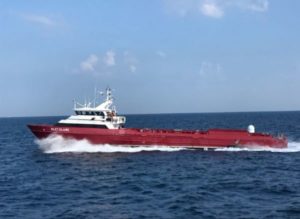The Navy’s top acquisition official said he thinks the Navy will work out unmanned vessel development disagreements with Congress and said they have to strike the right balance on development and prototypes.
“We’ve got to work closely with the Hill to give them confidence. You know, their concern is we’re moving out too quickly” on unmanned surface vessel (USV) and unmanned underwater vessel (UUV) technology development, Assistant Secretary of the Navy for Research, Development and Acquisition James Geurts said during an online event hosted by the United States Navy Memorial organization on Monday.

Geurts acknowledged an important issue from the Senate Armed Services Committee’s fiscal year 2021 defense authorization bill in particular “is a concern that we have our arms around the technology, do we understand all the prototyping necessary to have high confidence in the technology.”
The Senate bill would require the Navy to qualify the main engines and generators for USVs before moving to procurement and the Undersecretary of Defense for Research and Engineering must review USVs and UUVs before they receive full vessel research and development funding (Defense Daily, June 11).
Last month, committee aides told reporters intent is to require technological maturity and make a distinction between subsystems and full-scale prototyping.
Geurts said the Navy will work closely with Congress to ensure full transparency, but from his perspective “the biggest challenge in the unmanned arena is not the technology per se, there’s certainly some technology elements to work on, it’s really the concept of operations, the command and control, the concept of employment, and so I do think there is a balance we’ve got to strike with getting some prototypes out to the field so that the fleet can understand how to best utilize what’s available.”
He added the Navy has to balance those concepts with discipline, programmatics and “that’s the balance we’re working to put together right now and we’ll continue to work closely with Congress on it.”
The House is also seeking to limit unmanned vessel development.
The House Armed Services Seapower and Projection Forces subcommittee mark of the FY ’21 defense authorization bill would prohibit procuring any Large USVs (LUSVs) until a technology maturation certification is submitted to Congress. The certification would guarantee the hull, mechanical and electric systems of the LUSV have at least attained technology readiness level seven and can be autonomously controlled for at least 30 days (Defense Daily, June 23).
Then in the HASC chairman’s mark, the subcommittee also recommended cutting funds for two LUSV prototypes until the program can prove enough design maturity and understand autonomy. HASC staffers told reporters last month their committee is wary of moving into serial production too quickly with capabilities the Navy does not completely understand.
Geurts underscored early unmanned prototypes are extremely valuable because they have to understand how to operate the systems in a way that makes sense.
He compared USVs and UUVs to his time at Special Operations Command early in the Afghanistan and Iraq Wars.
“We had UAVs, we weren’t quite certain how to use them to their full advantage, and so we almost had this combination of get them out there early enough to understand the opportunities they represent but not so early that they’re not trustworthy on the battlefield.”
“We’ve got to find that same balance I think on the unmanned surface vehicle side,” he added.